
Wednesday, 5 January - According to an article I saw in the October issue of The Wine Enthusiast, Najera is the up-and-coming place in the Rioja wine region, but Frommer's didn't have much to say about Najera. Frommer's describes Haro as the hub of the Rioja wine region, so we rented a car in Burgos and headed east to Haro. Most of the snow had melted by the time we left Burgos, and as we dropped in altitude all evidence of snowfall receded in our rearview mirror. What lay before us was green and pastoral, if somewhat hazy.

It was a fairly quick drive to Haro - about an hour, and we rolled into town around noon. Haro is a fairly small town but it has lots of wineries. Our Rick Steve's book defines "bodega" as "cellar", but apparently "bodega" equates to winery as well. Anyway, there were about fifteen bodegas within walking distance of our hotel, and we walked to about ten of them before concluding that all of them were closed in anticipation of the Three Kings holiday, which was the following day. We knew about this in advance from Frommer's but the book made no mention of the fact that all the wineries would be closed for this occasion. It specifically mentioned other dates when the wineries would be closed, so we erroneously inferred that we would be able to spend the day sampling wines from the region.
Apparently we were not the only ones who made this mistake. We watched other groups pull up to the wineries, try the doors, and then drive away dejected. We ran into one Spanish family at three separate places so we didn't feel like we were the only fools to make this mistake. We may have been the only fools to come six thousand miles to make this mistake, but that was beside the point.
On the upside, we managed to work up a pretty good appetite walking up and down the hills, so we consulted those lying bastards at Frommer's for a good restaurant recommendation. There are several restaurants in town by the name of Beethoven. There's Beethoven I, Beethoven II, and (if you believe what you read in Frommer's) Beethoven III. Since the book had gone to press, the folks at Beethoven had apparently decided that I and II was all the market would bear, however, because those were the only two that appeared on the map that our hotel provided. Because of the confluence of holidays (or festivas, as they call them in Spain), only one Beethoven was open on January 5th but that was okay - we really only needed one.
There weren't many vegetables on the menu, oddly enough - except for "white beans and ham" (if that counts as a vegetable), vegetable stew, and asparagus salad. Daisy had the beans, I had the stew, and we decided to share an asparagus salad. Imagine our surprise when the asparagus salad turned out to be canned white asparagus and a few scraps of lettuce. These were asparagus of unusual size. I don't know if this was caused by the vacuum associated with the canning process or what, but I renamed them the John Holmes Memorial Asparagus.
Daisy's white beans turned out to be pinto beans and sausage - pork and beans, basically. Also note, pinto beans are red, not white, but that was okay - we were just glad that weren't out of a can. Most of the ingredients in my vegetable stew on the other hand, were out of a can, or a jar. In fact, unless they marinate their own artichoke hearts, the only ingredient that wasn't out of a can was the zucchini.
For some reason I wasn't really in the mood for meat, so for the main course I had fish. Hake, in fact, whatever that is - I think it's monkfish. Daisy had cod. I ordered the hake in red pepper sauce, for some reason focusing more on "red pepper" and failing to consider the implications of "sauce". When it arrived however, it was impossible not to notice the sauce, although it was possible to scrape most of it off to get at the fish, which was not bad - unlike Daisy's cod, which she described as "chewy". I had a hard time believing that fish could actually be chewy, but after chewing for about thirty seconds on the bite that she gave me I had to admit that "chewy" was not an unreasonable characterization. "Stringy" might have been better, but "chewy" was not inaccurate. If you've ever eaten dried cuttlefish, imagine rehydrating a bag of it by boiling it for a while - and you'll get a pretty good idea of what I'm talking about.
Whining and Dining or Spain on 5 Rolaids a day
This is our eighth day in Spain and I can say with some authority now that Spanish food is great... if you're from the Midwest and you like meat, and lots of it. They also have plenty of fish, fried or broiled with one kind of greasy sauce or another, but I like to temper my dead animal intake with lots of vegetable dishes and pasta, and here, unfortunately our story turns a little bit sad. In the half-dozen or so times that we've ordered asparagus since our first night in Madrid, on only two occasions have we been served traditional green asparagus. Every other time they were white, and like most vegetables that they serve here, they were fresh... out of the can. When you can get vegetables at all up north(they do not appear prominently on menus), they are invariably canned. Maybe this has to do with the season, but I know that they have fresh oranges and pineapples here - I don't know why the technology has evaded them to transport fresh vegetables. Apparently they've done a cost/benefit analysis and decided that it's not worth the additional expense just to satisfy the culinary whims of some whiny tourists from California.
Similarly, pasta is out of the question. If you want a noodle, you're going to have to go to a Chinese (Chino) or Italian restaurant. We have not mustered the courage to venture into either such establishment, but a cursory perusal of the color photos on the menu outside a Chinese restaurant revealed a cornucopia of dishes that feature meat, meat with noodles, chicken with noodles, and the occasional chicken with canned mushrooms. If you want rice, order paella. If you want aroz con pollo (chicken and rice), forget about it. As a child I learned in my Spanish class that aroz con pollo was a staple dish. Maybe this tradition has died since I took Spanish, or as Daisy has suggested, maybe my teacher was talking about Mexico. That's possible I suppose - I never paid much attention in Spanish class. Be that as it may, I've abandoned all hope of expatriating to Spain and sit out the remainder of the Bush administration. Next stop Vancouver, I guess...
For those of you who like meat, and lots of it, you're gonna love Spain. My grandparents traveled to Spain often in the sixties and they loved it here. In retrospect, I recall that my grandmother never cooked a dish that didn't involve the demise of some kind of animal. Admittedly, it might only be a fish, and occasionnally there would be a small portion of Uncle Ben's rice - but forget about spaghetti pomodoro,. "Penne Arabiata" just wasn't even in her vocabulary. Neither were "fresh vegetables" if memory serves.
To sum up, Spanish food is the most meat-intensive food I've had in Europe. To put it into context, I prefer English food to Spanish food. I haven't been subjected to such a lard-laden diet since my last visit to Alabama, which, with any luck will remain my last visit to Alabama.
Now that I've gotten that off my chest...
After lunch (which included wine) we returned to our hotel and I decided to rest my eyes for a few minutes. Just to be faithful to the siesta tradition, you understand...
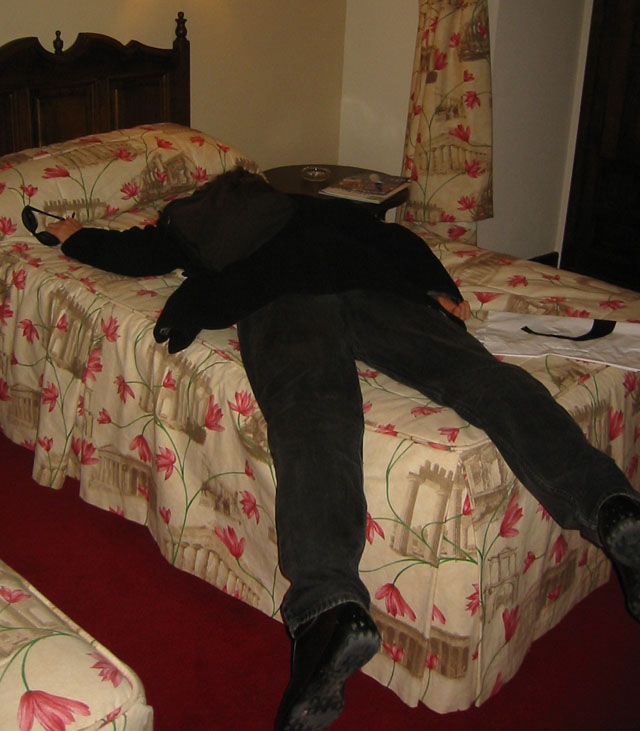
When I woke up three hours later, the town was abuzz in preparation for the big celebration that occurs the night before the Three Kings holiday. It was about 5:45 and the parade was scheduled to begin at 6, so we splashed water on our faces and headed down to the street to see what all the excitement was about.
A parade route had been roped off earlier that afternoon, and we happened to have situated ourselves along an early part of the route. Contrary to what I expected, Three Kings Day had nothing to do with the George Clooney / Ice Cube movie of the same name. I'm not sure exactly what the tradition is, but it involves some guys dressed up like what appears to old Hebrew kings, and a bunch of kids throwing candy to (at, really) the bystanders. I snapped a few pictures when I wasn't busy stuffing my pockets with candy.
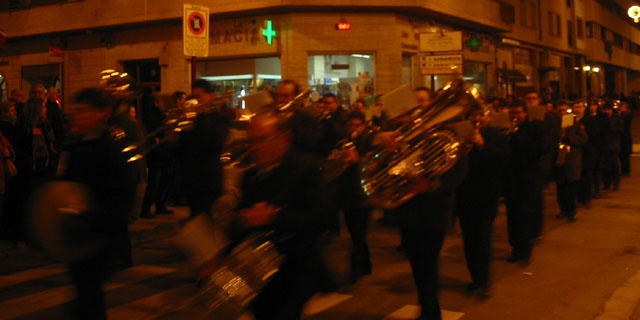

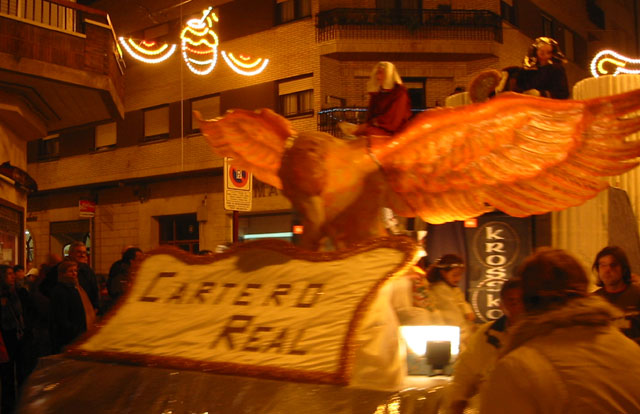
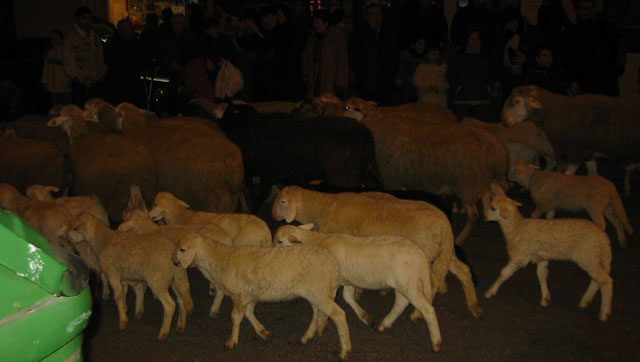



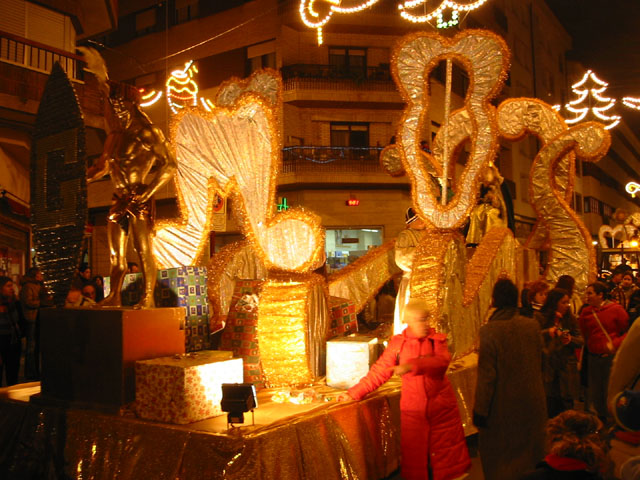
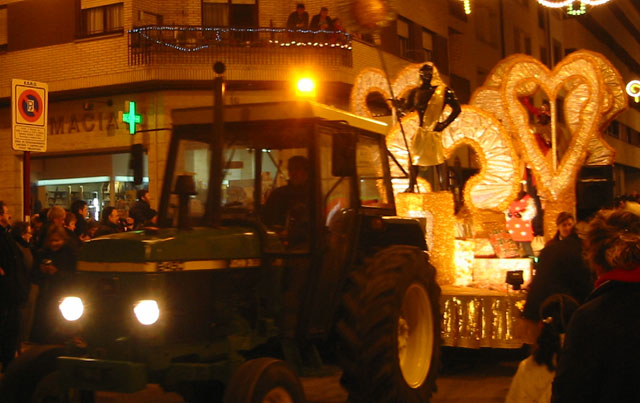
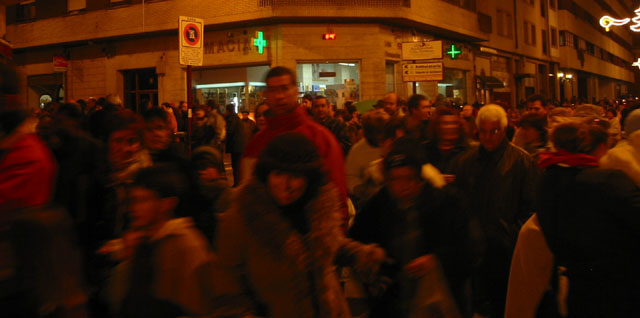
After the parade we went back up to our room, but rather than watching the latest fifteen-minute loop of CNN tsunami coverag, we decided to watch the live coverage from Madrid of the floats going down the main boulevard - one of which contained some guy dressed up like what appears to be an old Hebrew king, and a bunch of kids throwing candy at the bystanders. I didn't really understand what it was all about but it was somehow more uplifting than watching a bunch of sunbathers being swept away to their death. I guess I'm getting sentimental in my old age.
Earlier that day I had noticed in the hotel lobby that the hotel restaurant menu featured vegetable stew", so at 10 PM we went down to the hotel restaurant. Alas, when they took our order the waitress regrettably informed me that the vegetable stew was "finished". I'm not sure whether that was their way of saying it wasn't on the menu that day or that it wasn't done cooking yet, but since we were only the second party in the restaurant I'm quite sure they hadn't run out - per se. Fortunately, the menu also featured "beans and sausage", so I ordered that as an appetizer.
-------------------------------------------------------------
Thursday, 6 January - We drove from Haro to the northeastern city of San Sebastian. It was a beautiful drive and I really had to think twice about my aversion to what passes for cuisine in Spain. We drove through a lot of beautiful wine country, and I began to tell myself that if we cooked at home - as we typically do in the states, that I could take a more proactive roll in what's on the menu. They do have fresh produce here after all; we've seen the produce stores. The ratio of carnicerias to produce stores is about 10:1 but they do exist.
One of the smallest towns we passed, just a few kilometers out of Haro was Sansol. We only drove past the town so for all I know it may have been a dump, but from the outskirts it was beautiful.


San Sebastian is in the Basque region of Spain, very near the French border and not that far from the Bordeaux region. As you get closer and closer to France the countryside begins to look more and more like what you would expect to see in France, and because it's mountainous terrain that borders on the Atlantic it picks up a lot of rainfall - at least at this time of year. The proximity to the ocean also makes for a more temperate climate, and we haven't seen any snow really since we left Burgos two days ago.
Because we were in a bit of a hurry to get to San Sebastian and to have a look around there, I didn't have the opportunity to make an excursion into Najera, which is supposed to be the next up-and-coming town in the Rioja region. Apart from acquainting myself with the lay of the land, there isn't much that we could have done, as January 6th is Three Kings Day, and as was the case in Haro, all the bodegas would surely have been closed.
We did make a brief detour so that I could see what Pamplona looked like, and I was surprised to learn that
A) It's a BIG, modern city
And
B) The surrounding country is green and beautiful - at least at this time of year.
We never figured out where they run the bulls, but we did find an ancient walled city near the center of town that reminded us of Lucca in Italy. It may have been inside there, but we didn't have the time to take out of our schedule to investigate further.
When we got to San Sebastian, Daisy checked us into the hotel while I returned the rental car, and then we walked half way around the bay and up the mountain that overlooks the bay. Because it was fairly overcast, the lighting was less than optimal for my photo-taking but you can at least get an idea of what San Sebastian looks like in January. It wasn't very cold and we didn't even have to wear our jackets on the hike up the hill.


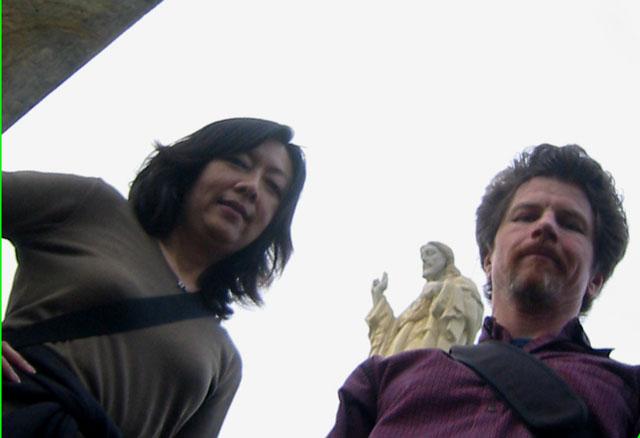
Because this is Basque country we made it a point to ask the concierge for a recommendation on a Basque restaurant that not only featured good Basque seafood, but also was open on Three Kings Day. I was pleased with what we found. It turns out that Basque food really isn't that different from Spanish food, but the place we went to had a few more vegetables on the menu. With the exception of the cauliflower and carrots they were all canned, but one of the dishes I ordered was green runner beans (essentially string beans), and it so happens that I like canned green beans. What was really amazing were the portions (or raciones) of the vegetable dishes. In addition to an appetizer of fois gras (which turned out to be just pate) I ordered two vegetable dishes, which proved to be two full-sized plates overflowing with veggies. Each plate consisted of more food than anything I had been served since our paella experience in Madrid. When my main course of three scallops arrived (at 6 euros apiece, and each about the size of a water chestnut), we were back to the typical theme of small portions at large prices - but by then I had gorged myself on veggies, and three scallops was plenty. The wine was also very good. By now I had abandoned my Rioja theme and instead went with something from the Ribera Del Duero region. Based on my limited samplings thus far, I think I like the Ribera Del Duero more than the watery stuff I had in Haro.
Friday, 7 January - I turned in around 10 or 10:30 and was astonished when I awoke at 6:30 this morning when the alarm went off. Maybe it's just taken me 9 days to shake off the jet-lag but I'm much more inclined to believe it's because of what I ate last night - and more specifically, what I didn't eat.
Because I didn't feel like I had a side of beef in my stomach last night I decided to throw caution to the wind and arrange to have breakfast in our room this morning. This is the first time we've tried anything that decadent since we got to Spain, and lo-and-behold, I actually had an appetite for more than cafe con leche. More than coincidence?
We shall see.
back to Burgos